What’s in a scale? More to the point, what’s in “the Cooper scale”? This short primer on scale — and why every flutist needs to understand its importance — includes a heartfelt appeal for the open information-sharing that defined the character of the late Albert Cooper.The crucial concept of “scale” in the lives of flutists began, more or less, with Theobald Böhm — and, sadly, its technical understanding largely ended with his death in 1881.But throughout much of the 20th century, a gang of mostly British flutist-technicians (along with myself as a token American), searched for ways to improve the tuning (and with it the sound quality) of the modern flute.Following the death in 2011 of the group’s key member, Albert Cooper, the man whose name will be forever linked with the flutemaker’s Holy Grail — the Cooper Scale — there has come a renewed interest in explaining, disseminating, and perfecting the details of this approach, so that future flutists can continue the work that Cooper and his friends began.
In the Beginning
“Scale,” for our purposes, means a set of proportions that can be seen in the different placement of frets on a guitar fingerboard and the curve of a rank of organ pipes or piano strings.In equal temperament, these follow a simple mathematical formula.Multiplying by 1.06 (or 1.0594630948 or 12,-2.) increases the overall length proportionately to eventually reach the octave — exactly.Stringed instruments are well behaved and follow this rule closely.Sadly, flutes are not well behaved.Because we move our lips, intonation is a moving target.
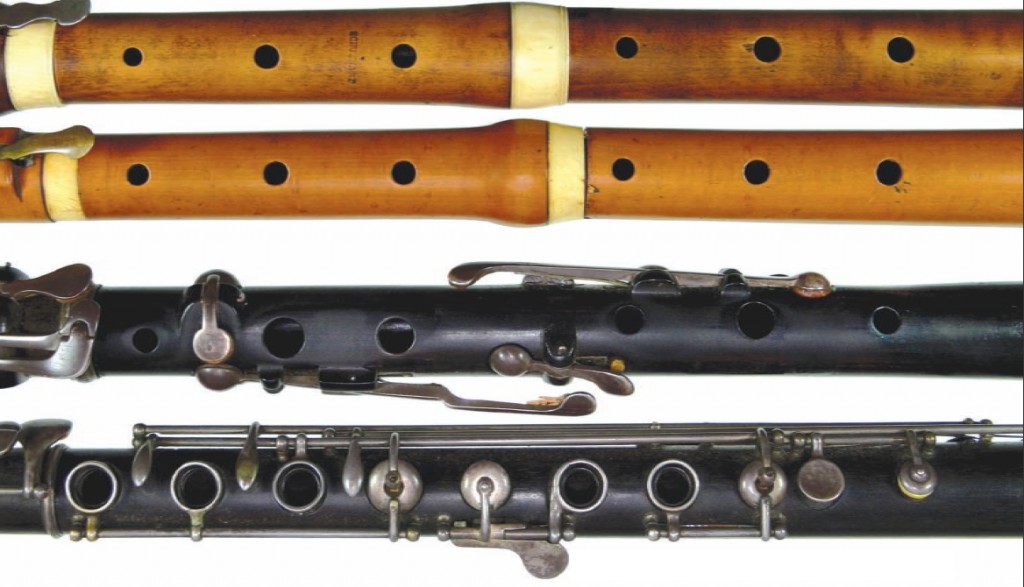
Before Theobald Böhm, the concept of “scale” was lost on flutists.Figures 1A and 1B in the photo above show two one-key flutes pitched at A=427 and 442, with nearly identical hole placement. While flutemakers were not concerned with mathematical abstractions, they were not ignorant.With the finger position decided on, tuning could be dealt with by changing the size of the holes.A larger hole raises the pitch and a smaller hole lowers it.Makers sometimes also undercut the tonehole, making it larger and raising the pitch without changing what you see on the outside.Remember this principle, as there will be a quiz later.The larger holes of our modern flute absolutely require an accurate “scale.” The photo’s figure 1C shows a Nicholson model flute, with the usual placement and wildly enlarged finger holes.Figure 1D shows an 1832 Böhm model flute as made by Rudall & Rose.This is Böhm’s direct response to the Nicholson instrument.Notice the absolute regularity of tonehole size and placement.Böhm’s understanding of “scales” must have been extraordinary, but the knowledge largely died with him.Flutemakers were left to copy existing instruments and make the occasional tweak.
A New Era
In the United States, we can easily imagine what happened with scales in the early 20th century.As the French style of playing became fashionable, so did French-style flutes — namely those made by Louis Lot.Most of these were intended for diapason normale, or A=435.These can be played at A=440 by shortening the headjoint, but this leaves the holes too far apart.If A is in tune, C-sharp will be sharp and the low notes will be flat.This is what the famous flutists played, so customers wanted a copy, and makers did their best to provide.A flutemaker might tweak something here or there, but they would have been crazy to deviate significantly from the “ideal.” Players learned to adjust for the errant notes (with mixed success), creating a paradox: a theoretically perfect flute would have been unacceptable, because established players would find the low notes sharp and the C-sharp flat!And this is exactly what happened.
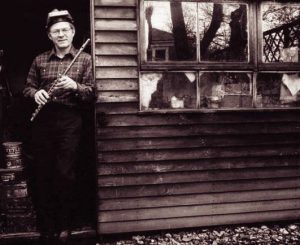
In 1974, Bickford Brannen visited Albert Cooper in London, brought the scale back to Powell Flutes, and so contributed to an historic decision.Powell, at the height of prestige and with no need to innovate, introduced not just a new scale but an entirely new instrument and approach to flutemaking.It is difficult today to appreciate the controversy this created.This pivotal moment in our history deserves a separate article, if not a book.Suffice it to say that we are all deeply indebted to Bick Brannen for taking the first step on this groundbreaking journey.
Across the Pond
One does wonder why this new scale came from London and not some American corporation or university.The answer seems to be found in our different histories and attitudes.In the US, flutes were (and are) considered art objects.Tampering was strictly forbidden and so experimentation was discouraged.Verne Powell left us with many colorful quotes, one of which nicely sums up the American attitude toward innovation: “I made it, it’s right, go play it!”The situation in England could not have been more different.Like the Powell scale in the U.S., the Rudall & Carte “schema” was presumed perfect.However, Rudall & Carte made quite a few “HP” (high pitch) flutes, and with the establishment of A=440 as the international standard (1939), these became obsolete.R&C could have sold many new flutes but instead transplanted the old mechanism to a new tube at the new pitch.This in itself was not “experimentation”; the concept of repurposing flutes was well established.Further, London flute players are arguably (pun intended) more critical of flutes and flutemakers.Everyone seems to have strong opinions and “agreeing to disagree” is an absolute tradition.By the 1950s, R&C had gone into decline and then folded.This removed the sort of central authority the U.S. had in Boston and also left a number of highly skilled craftsmen to fend for themselves, most notably Albert Cooper.
The Cooper Scale “Brand”
When Powell (and later Brannen Brothers) invested in the Cooper scale, it became a brand — and should have.The companies took risks, and Cooper certainly deserved financial reward and every bit of credit.That said, Albert Cooper did not invent the scale out of whole cloth.What became “the Cooper scale” evolved as a group effort, with input from many different players.What in the United States became an industrial property remained “Cooper’s scale” to those who had played a part in its development.
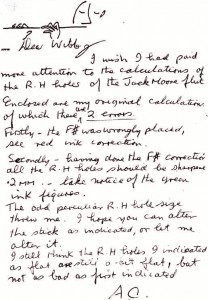
The best known of these is William Bennett (aka WIBB), author of the William Bennett scale.Cooper and WIBB agreed to disagree on some details but were long-time friends who shared information and opinions freely.It was WIBB who first said, “If the hole is in the wrong place, move it!” And he did, beginning in 1954.In 1956 he invented the technique of “patching” toneholes.This allowed an incremental approach to tuning flutes rather than building an entirely new instrument to test every possibility.The process has always been one of trial and error, and without this expediency, progress would have been slow indeed.Cooper left R&C and began making his own flutes around 1958.Both he and WIBB experimented with fixing the worst notes, but a systematic approach was needed.The person who most deserves recognition here is Elmer Cole, principal flutist with the English National Opera Orchestra for nearly 35 years.(Cole also invented the convertible footjoint, an improved system of trill keys, and who knows what else.) Cole had ordered a flute from Cooper around this time, and as it was being made, Alex Murray (inventor of the Murray-system flute) suggested Cole look into Böhm’s book.He did, but unfortunately, the flute was finished too soon to incorporate the new ideas.
The Cole Factor
Regardless, Elmer Cole set the entire effort on a straight course by insisting that, whatever else, the scale must have an underlying mathematical basis.He coined the term “octave length” and laid the groundwork for everything that followed.And octave length continues to be a subject of discussion.It determines the overall pitch of a scale (A=440, 442, or whatever)—and small uncertainties still continue about the best starting measurement and how, exactly, to proportion the tonehole placement.Obviously, Albert Cooper made the largest contributions to the effort.Among many things, he developed a “displacement graph” that enabled makers to substitute different-sized toneholes in a predictable way.Just one example of Cooper’s quiet genius: When the strict “Böhm schema” was tried, the left-hand notes were found to be flat—a very serious problem.Instead of belaboring theory, Cooper simply (but rationally) jumped to a workable solution.In essence, he grafted two different scales together—what we now call the “Cooper stretch.”This was a major breakthrough, and one that Cooper could well have kept to himself.Instead, all developments were shared, discussed, and incorporated into the general effort.This attitude of sharing both effort and credit seems difficult for Americans to understand, i.e.: “My scale is better than your scale!”This is not to say there was agreement on every item.Everyone was working toward a common goal — better flutes — but not necessarily a common solution.There are myriad compromises, and everyone had slightly different opinions.Quite remarkably, there was a common understanding of what the compromises were and why certain choices were made.As an example, the octave between low and middle D tends to be wide.If you make the low D “in tune,” the middle D will be sharp.Conversely, if the middle D is “in tune,” low D will be flat.What to do?Cooper reasoned that since third-space C-sharp also tends to be sharp, putting two sharp notes together might lead players astray.WIBB reasoned that if the player is already adjusting the C-sharp, why not humor the D as well?They were both right.To be clear: despite superficial differences, both Cooper and Bennett scales were always based on these same underlying concepts and measurements.I last saw Albert Cooper at the 1998 NFA Phoenix convention (at which, along with Charles DeLaney, he received the NFA’s Lifetime Achievement Award).He was his usual cheerful self, but a bit contemplative.He said quite clearly that he thought “the scale” was essentially complete, yet there were still details to be worked out, and that WIBB would likely run those to ground.There was nothing about “his scale”—it would have been out of character.
Keeping the Scale Alive
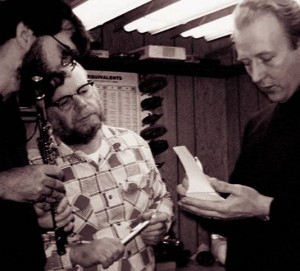
More than a decade ago, WIBB voiced concern that as the principal characters age and die, the process leading to “the scale” would be lost.This started me on a mission to document as much as possible.Sadly, this was about the time that Albert stepped in front of an oncoming car.He never really recovered, and WIBB’s fears were partially realized.
Fortunately, WIBB kept detailed notes from the start.In reviewing five decades of his research, I noted a pattern of uncertainty about the tonehole displacement graph and the adjustments needed for open holes.Trevor Wye (another significant contributor and the engine behind our present effort) had built a mechanical flute player in the early days and got it working well enough to prove that things were actually headed in the right direction.It seemed a simple project to build another, take a few measurements, and settle matters.
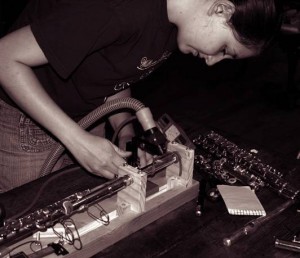
Right. Wye’s students called his machine an “Automated Trevor.” Borrowing computer technology, I dubbed mine “Trevor 3.0.” Years and sleepless nights later, “Trevor 5.3” isbeginning to behave predictably, and the open-hole corrections are taking shape.The displacement graph just might come together in the next year.
Everybody Else
As the initial controversy subsided, other makers were left to make tough choices.A few companies really did try to develop their own scales from scratch, with mixed success, but a simpler approach was to copy a “Cooper scale” flute and use it without giving credit.Or they could get the William Bennett scale for asking.Or they could copy either and announce their new “Brand XXX” scale.Or they could tweak something (usually for the worse) and claim to have invented the thing entirely.In any case, these came after the fact.It was the initial concept that mattered, and once the idea of improved tuning was accepted, anything seemed possible.Sadly, in the past few years WIBB, Trevor Wye, and I have become increasingly concerned (annoyed/frustrated) at having students with expensive flutes that are obviously (in our opinion) out of tune.We don’t mean to appoint ourselves the “pitch police,” but it’s been a long road, and the desire to make everyone’s lives easier remains.We hoped that if we published the actual numbers, flutemakers could use them directly or at least compare their numbers to ours and note the differences.Thus, we offer — in a gesture of the openness and sharing that was a hallmark Albert Cooper’s character — our most recent numbers for all to view and use.You can find them (and much more useful information from Wye, a 2011 Lifetime Achievement Award recipient) at trevorwye.com.They also are available in one easy-to-find location at eldredspellflutes.com/scales/index.htmThis article first appeared in the spring 2012 issue of The Flutist Quarterly, the membership magazine of the National Flute Association, and appears here with permission.

